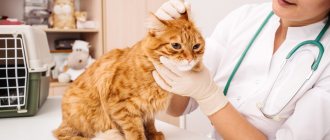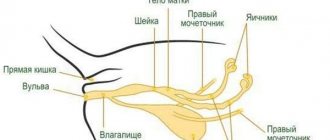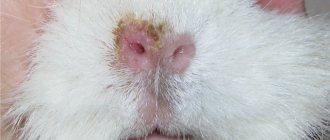If a cat shakes its head in good general condition and there are no external changes near the ears, then the cause may be wax plugs, drops of water, or small foreign objects. If there is itching or signs of scratching, an allergy or infection with mites can be assumed. If an inflammatory response occurs due to infection, symptoms include redness of the skin, discharge, and fever.
Traumatic injuries are characterized by visible or hidden accumulation of blood under the skin (hematoma) and the appearance of wounds. Shaking the head and unsteadiness when walking are typical for brain damage due to traumatic brain injury, encephalitis, or tumor process.
If there are any persistent signs of illness, deterioration in the cat’s general condition, or lack of appetite, you should definitely contact a veterinarian. After the examination, ear drops are prescribed (for example, Amitrazine, Surolan), supplemented, if necessary, with antibiotics and immune system stimulants.
When is it normal for a cat to shake his head?
The cat shakes its head when washing and licking, cleaning its ears. All this is considered the norm, since careful hygiene procedures are typical for healthy animals. Diseases can also be caused by ingestion of fluff or small parts of plants. Twitching of the head (as well as the whole body) occurs in cats before a jump, as well as during hormonal surges. A heart-rending cry and a general excited state are possible during this period.
For cats with small ears, the habit of head shaking occurs when the ear canal does not clean itself properly. Therefore, it is recommended to regularly help them with maintaining hygiene - cleaning their ears monthly. Natural factors are usually short-term, they do not affect the activity of animals or appetite. There is no redness, swelling or any discharge near the ear or inside.
Injuries
Domestic cats experience fewer injuries, since there are many risks on the street in the form of fights with relatives or other animals. If the injury is severe (for example, after a fall from a height), the pet may shake its head for a while and lean to one side. If this condition does not go away within 24 hours, it is recommended to immediately take him to the nearest veterinary clinic. To make a diagnosis, it will be necessary to exclude injuries to the skull, cervical spine, and concussion. Injuries can also include insect bites, after which the cat not only shakes its head, but also rushes around the house. We are talking about wasp and bee stings in the area of the nose, lips, ears and eyes. The bite site always swells and turns red. It is recommended to immediately give your pet an antihistamine (Fenistil, Cetirizine).
If a cat scratches its ear and shakes its head: the main reasons
If a cat constantly scratches its ear and shakes its head, then you need to pay attention to the appearance of the ears and other general symptoms; they usually indicate diseases - otodectosis, notoedrosis, demodicosis, otitis media and others.
Otodectosis
When infected with ear mites, otodectosis develops. It feeds on the desquamated epidermis of the external auditory canal, blood and lymph. Its secretions irritate the skin, which manifests itself as:
- persistent itching;
- jerking the head (trying to shake something out of the ears);
- general anxiety of the animal;
- loss of appetite;
- hair loss near the ears;
- traces of scratches and crusts;
- brownish discharge from the ears with an unpleasant odor.
If the disease is not detected in time, then inflammation and suppuration may begin in the areas of scratching. This is accompanied by a deterioration in the animal’s condition, it becomes lethargic, and the body temperature rises. At risk of ear scabies are kittens and older cats suffering from chronic kidney disease, lung disease, and other infections.
Infection most often occurs in spring and summer and is transmitted from a sick animal. With advanced otodectosis, deafness and damage to the vascular membranes of the brain are possible.
Notoedrosis in a cat
Notoedrosis is similar to otodectosis; it is also caused by microscopic mites (their size is less than 0.5 mm). They affect not only the ears, but also spread throughout the animal’s body. When they come into contact with the skin, these parasites bite through the outer layer and move forward, forming tunnels. This process is accompanied by persistent itching and hair loss.
Upon examination, you can notice traces of scratching, some of them bleed, and some become covered with crusts. Due to constant itching, animals' appetite decreases and sleep is disturbed.
Twitching with demodicosis
If a cat often twitches its ears and head, then one of the reasons may be another type of mite - demodex. They actively multiply on the skin of the body, including near the auricle and on the eyelids. A characteristic feature of this disease is that it occurs and progresses rapidly when the body’s immune defenses are weakened. The first symptoms occur against the background of infection or during long-term treatment with potent medications.
The disease occurs in two forms - with itching, scratching of the skin and hair loss, or the cat has only intense baldness, and the skin is not changed.
With pain from otitis media
If a cat has an earache, he shakes his head, scratches the auricle, presses it to his head, and twitches his ears. Such signs are characteristic of otitis media - an inflammatory process in the outer, middle, and inner ear. The disease occurs due to hypothermia, infection, and can also be caused by allergies, foreign bodies, water, or trauma. The typical appearance of otitis media is:
- clear or purulent discharge from the auricle;
- scratching the parotid skin to wounds;
- refusal to eat (when chewing, the pain from ear inflammation intensifies);
- anxiety, sometimes aggressiveness;
- gurgling sounds inside the ear;
- avoiding stroking the head;
- redness of the ears;
- enlarged lymph nodes (oval lumps near the ears).
Advanced otitis media leads to hearing loss and the spread of infection to the meninges.
Ear inflammation with sneezing
Ear inflammation with sneezing occurs due to an allergic reaction to food, household chemicals, litter for the tray, perfumes and cosmetics, paint, or cigarette smoke. With severe swelling of the mucous membranes, breathing becomes difficult, and the edematous tissues block the outflow from the Eustachian tube (it connects the nasal and ear passages). Less commonly, the cause is a viral or fungal infection. Their symptoms are similar:
- discharge from the nose and ears;
- wheezing or heavy breathing, shortness of breath;
- loss of appetite;
- itchy skin;
- vomit.
With allergic otitis media and rhinitis (runny nose), there is no increase in temperature, but with an infectious origin it can increase.
Hematoma in a kitten and an adult animal
A hematoma is an accumulation of blood; if it occurs in a kitten or an adult cat, the cause is most often injury, a fight, or a fall. They lead to rupture of blood vessels and hemorrhages between the cartilage tissue and the skin. The animal becomes restless, meows and shakes its head, tries to scratch the inside of its ear, and presses the auricle to its head.
When scratching, infection can occur, which leads to suppuration and the formation of an abscess (ulcer).
Sulfur plug
Earwax in the ear causes the cat to shake its head, but the ears may still be clean on the outside. This happens when the earwax is too thick and is sometimes explained by the anatomical features of the structure of the ear canal. Long-term presence of wax plugs causes hearing loss in cats.
Allergy
With a skin allergy, cats may have rashes and persistent itching. Irritation, redness, and weeping lesions may occur in the ear area. With a chronic allergic process, dermatitis (inflammation of the skin) develops. Provoking factors for this disease are:
- fleas, ticks;
- intolerance to food or feed components;
- the use of medications, especially ear drops and ointments.
The contract allergen can only be determined through examination.
Shakes his head when there is a foreign body
A foreign body gets into the ears during a fight, in nature (for example, a piece of a branch, a small pebble), as well as at home (a piece of a toy, fibers from a scratching post, part of a plant). Cats shake and shake their heads and scratch their ears.
If a foreign object gets deep into the ear canal, the animal cannot get rid of it on its own. The owner is also not always able to remove small particles from the ear without a special device. Additional injuries may result from careless movements.
Shakes and licks when injured
Head and ear injuries can cause local damage - a wound, hematoma, abscess. The symptoms are:
- swelling,
- edema,
- redness,
- discharge from the ear.
With a traumatic brain injury, not only skin symptoms are possible, but also more serious disorders of brain function (weakness, unsteadiness, behavioral changes).
Neoplasms
When a tumor develops inside the ear canal, the cat presses its ears and shakes its head, and other symptoms are also possible:
- putrid odor;
- ear scratching;
- discharge: bloody, with pus or dark;
- change in ear shape;
- hair loss in the parotid area;
- hearing loss on one side.
Cats after 7 years of age, as well as animals with chronic inflammatory processes in the hearing organ, are prone to tumor diseases.
Neurological diseases
If, after an injury, a kitten or adult cat shakes its head, limps, staggers when walking and falls, then such symptoms indicate damage to brain structures. Neurological disorders are also typical for vascular diseases (stroke) and infections (encephalitis or meningitis).
The animal’s behavior often becomes inappropriate - unmotivated aggression or complete apathy occurs (the cat does not react to others). For example, he may stare at a wall for hours or bump into obstacles or walk in circles.
Dermatitis or eczema
Dermatitis or eczema of the ear canal causes severe itching and twitching of the cat's head. They can appear against the background of allergies, infections, lack of vitamins, as well as circulatory disorders. Redness and skin irritation may occur even after treatment with potent medications.
Foreign body
A foreign body entering the ear canal causes the cat to shake its head and behave restlessly. If the splinter is not removed in time, the development of purulent otitis media is inevitable. The foreign body can be thorns from a cactus, plants, or the remains of claws after a fight with relatives. When removing the splinter yourself, it is recommended to thoroughly disinfect the wound and the tools that will be used to remove the splinter. If after extraction no purulent discharge or unpleasant odor appears within 3-5 days, then we can assume that everything went well. Otherwise, it is better to immediately take your pet to the veterinarian.
Treatment for when a cat shakes its ears
If a cat is shaking its ears due to a mite infestation, then the most commonly used ear drops are Amitrazine. Drugs with similar effects can also be prescribed - Stronghold Aurican, Tsipam, Amit, Dekta, Otidez. They contain components that block the vital activity of parasites and relieve itching. On average, the course of treatment is 5-7 days. If necessary, anti-inflammatory and hormonal drops are also used at the same time.
For bacterial infections, a solution is used for instillation into the ears - Surolan, Otidez, Otospectrin. They contain antibiotics, painkillers and antipruritic drugs. Therapy continues for at least a week. In case of suppuration and acute otitis media, antibacterial medications must be given orally or injected after detection of the pathogen.
If fungus is found in the ears, Anandin Plus and Oridermil gel will help.
In case of a tumor, hematoma, or deep penetration of a foreign body, surgery will be required.
Prerequisites for successful therapy:
- instillation is carried out after cleansing the ears;
- with reduced immunity, they give vitamins and tablets that increase the immune response;
- deworming (getting rid of worms) is often carried out at the same time;
- During the treatment period, the animal must be provided with rest and adequate nutrition.
Neoplasms
Often found in individuals after 5 years of age. They have benign (polyps, papillomas) and malignant
nature (sarcoma, lymphoma, carcinoma, melanoma). Almost always, all neoplasms provoke the development of otitis media and discharge from one (affected) ear. In advanced cases, the cat shakes its head and leans to the side. For single polyps of small size, you can limit yourself to observation and in the absence of growth and inflammation, you can leave it alone. If the polyp increases in size or provokes otitis media, then its removal is necessary. The prognosis is favorable in most cases. Everything is more complicated with malignant tumors, due to which blood and pus can be released from the ears. There is a foul odor. To confirm the diagnosis and determine the stage of the tumor, otoscopy, MRI of the head and radiography are performed. In the absence of metastases, surgical excision of the formation is performed, including healthy tissue (in 70% of cases, the entire ear canal is removed). And even if the operation is successful, the prognosis is cautious, since malignant tumors in the ears are prone to recurrence.
Rules for cleaning ears
Once a month, your cat's ears need to be cleaned to prevent ear diseases. To do this, it is important to choose a time when the animal is completely calm. Sudden movements can damage the skin. To cleanse, take saline solution and heat it to body temperature.
Moisten a cotton pad and carefully wipe the inside and outside of the ear. Then you need to drop a few drops (3-5) of warm solution and very lightly massage the skin nearby. After this, use a cotton swab to carefully clean the ears of dirt.
If the animal is not given, the procedure is carried out by a veterinarian.
Pathological signs
Minor rare scratching (2-3 times a day) and head shaking cannot be called odd: all living organisms scratch and shake their heads, cats are no exception. But if the cat begins to itch constantly and at the same time tears his ears with his paws with all his might, you should pay special attention to this. These symptoms are often accompanied by other alarming signs that should alert the pet owner. These are the signs:
- The animal behaves restlessly, gets irritated and nervous for no reason.
- The cat actively shakes its head, tilts it down or to the side.
- When scratching its ears, the pet emits a hiss or an angry purr, and meows pitifully and loudly.
- Scratching left bloody marks inside and around the ears.
- The cat is trying to rub its muzzle and ears on everything around it.
- It is possible that the cat's body temperature may increase.
- The animal does not allow its ears and head to be touched, reacting painfully to any touch.
- The inner surface of the ear becomes red or swollen.
- Various discharges flow from the ear.
- Brown crusts and ulcers appeared in the ear.
Have you noticed this behavior in your cat? So it's time to see the vet.
What to do for prevention
To prevent the most common diseases when a cat shakes its head, you need to:
- examine ears and skin at least once a week;
- protect domestic cats from contact with street cats;
- prevent entry of water and foreign objects;
- regularly carry out preventive treatment against parasites;
- provide adequate nutrition, course intake of vitamins;
- If discharge, persistent itching, unusual behavior, or refusal to eat appear, immediately take the animal to the veterinarian.
The cat shakes its head with ear scabies, allergies, infections, injuries. If there is unsteadiness when walking, weakness, then it is necessary to exclude a tumor or brain damage. To treat ear diseases, drops are most often enough; in more serious cases, complex therapy is carried out with pills, injections, and surgery may be required.
Allergy
It can often manifest itself as dirty ears, itching, redness and baldness in specific areas of the body. In severe forms, the cat shakes its head and scratches its ears. You can see black discharge inside the ear canal. If there is a strong odor, then there is a possibility of a fungal or bacterial infection. This reaction is almost always provoked by incorrectly selected food and feeding the pet from the table. You also need to rule out flea dermatitis and allergies to parasites. Decorative breed cats (British, Scottish, bobtails, sphinxes, etc.) are prone to allergies. You need to understand that it will not be possible to get rid of dermatitis once and for all, so the animal will need special care throughout its life (hypoallergenic food, timely worming and flea treatment).
Otitis and its varieties
Otitis is an inflammatory process affecting the external, middle or internal auditory canal. There may be several reasons for the development of such a pathology:
- excess wax in the ears;
- colds caused by prolonged exposure to the cold;
- foreign bodies entering the ear;
- infections;
- allergy;
- diseases of internal organs (liver, pancreas);
- fungus;
- complication of notoedorza or otodecosis.
To prescribe the correct treatment, it is necessary to diagnose the cause of the disease in a specialized laboratory. The veterinarian must take a swab from the cat's ear for analysis.
In addition to ordinary otitis, in cats there is otitis of a bacterial nature, when a secondary bacterial infection is added to the inflammation of the ear.
In this case, the so-called bacterial or secondary otitis develops. It can be recognized by the abundant discharge of pus.
Otitis of mixed etiology also occurs in animals. This happens when the ear is affected by several types of otitis media at once. In this case, the disease occurs in a particularly severe form and causes serious complications.
How to help your pet
Options for providing assistance to the injured animal are selected after establishing the exact cause of the pathological condition.
Removing wax plugs at home
The cat begins to shake its head if it is bothered by wax plugs. You can clean your pet's ears yourself. Saline solution or hydrogen peroxide will help in this situation. The selected product is instilled into the ear canal, 2-3 drops three times a day. The treatment course lasts 7 days . Subsequently, the animal usually successfully copes with this problem on its own.
If the cat is unable to remove the plug, the owner himself can remove it using a cotton-tipped swab or a piece of gauze. As a last resort, it is recommended to contact a veterinary clinic.
Surgical intervention
Surgery may also be recommended in cases of chronic otitis media, which results in narrowing of the ear canal.
Diagnosis of ear diseases in cats
To understand what is hidden behind the cat’s behavior, it is necessary to conduct a thorough diagnosis.
The following studies will help determine the cause and make a diagnosis:
- examination of all parts of the body;
- general blood analysis;
- scraping from the affected area;
- histological examination of biopsy material;
- microscopic examination;
- bacteriological culture in case of detection of bacteria in a smear, also to determine antibiotic sensitivity.
Diagnostics of the auricle in the clinic
Based on the results of the examination, the veterinarian makes a diagnosis and prescribes appropriate treatment.
It is important to note that if you suspect the presence of ear scabies, it is mandatory to take the contents from the ear for analysis. But when complicated by bacterial otitis, detection of ticks is difficult, since they die in an acidic environment.
Ear mites
This mite is not dangerous to humans; it lives and reproduces only in animals, causing ear scabies or otodecosis in them. Adult dogs and cats rarely suffer from scabies, but ear mites are found much more often in puppies and kittens.
The parasite is localized in the ear area or around it. In the animal's ears, you can notice a sticky brown liquid that dries and crusts over the skin of the ear. To diagnose the disease, a scraping is made from the skin in the ear area. The owner himself can notice the tick using a magnifying glass.










